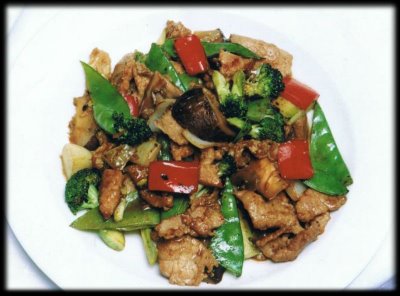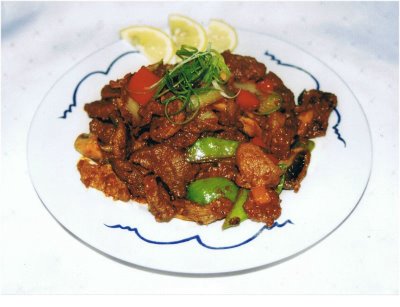 This is just a preliminary stage leading to the eventual setup for lemon chicken and tantalising sauce of other type. A choice selection of best chicken cuts from the chicken's prime breast fillets ensures superior 'finger licking good' than the banal prosaic KFC. Though it is nothing like a wok on the wild side as in other previous more exotic photo postings it nevertheless remain as classic as ever for the food lovers of all things Chinese and Cantonese throughout Australia. In the same vein it can be said that majority of the public would treat the rest of my photos with the same familiarity. Their original exposure may well be traced back as far as 1830's when the first Chinese gold miners and migrants brought their recipes to their camps in Oven Valley and Lambing Flats and from there beyond.
This is just a preliminary stage leading to the eventual setup for lemon chicken and tantalising sauce of other type. A choice selection of best chicken cuts from the chicken's prime breast fillets ensures superior 'finger licking good' than the banal prosaic KFC. Though it is nothing like a wok on the wild side as in other previous more exotic photo postings it nevertheless remain as classic as ever for the food lovers of all things Chinese and Cantonese throughout Australia. In the same vein it can be said that majority of the public would treat the rest of my photos with the same familiarity. Their original exposure may well be traced back as far as 1830's when the first Chinese gold miners and migrants brought their recipes to their camps in Oven Valley and Lambing Flats and from there beyond. A very common and popular dish which is generally very agreeable and pleasurable for a family feed when accompanied with some Chinese fried rice. Fermented black beans are bought in packets and contains excessive salt(sodium). The content must be soaked and stired in warm water and its high density salt separated and drain water before put to further use. Cover leftover washed black bean with vegetable oil to prevent moulding and preserve in sealed jars for future use. Never use more than one level tablespoon at a time for a dish . Chinese usually makes a mixture of1 tablespoon cornflour with a quarter cup of cold water to 1 tablespoon of fermeted black bean for a dish such as illustrated. This mixture is then pour in the last minute during the intensely heated stir fry( no more than 120 sec depending on heat) when marinated meat has been cooked.Cooked beef shows its puffiness due to result of its marination.
A very common and popular dish which is generally very agreeable and pleasurable for a family feed when accompanied with some Chinese fried rice. Fermented black beans are bought in packets and contains excessive salt(sodium). The content must be soaked and stired in warm water and its high density salt separated and drain water before put to further use. Cover leftover washed black bean with vegetable oil to prevent moulding and preserve in sealed jars for future use. Never use more than one level tablespoon at a time for a dish . Chinese usually makes a mixture of1 tablespoon cornflour with a quarter cup of cold water to 1 tablespoon of fermeted black bean for a dish such as illustrated. This mixture is then pour in the last minute during the intensely heated stir fry( no more than 120 sec depending on heat) when marinated meat has been cooked.Cooked beef shows its puffiness due to result of its marination.
Dom's Teahouse Lemon Chicken
That is exactly what will greet you when you get there . Personally I don't have a sweet tooth but my goodness they are just ever popular amongst the young and old. Our price are very affordable as well comparatively speaking. Vegetables are always fresh bright and colourful. You know you get them fresh. They are crunchy just blanched to the right milliminute and or seconds and they are not at all soggy or overcooked. This is a standalone Aussie classic. Perhaps this can serve as a good variation to additional taste sensation and a quick changeover to a different tang when the banquet gets too heavy on spices and curries.
Fried Rice Buck Bow Farn
 Here is another Australian Classic since the 60's. The word Buck Bow Farn denotes 8 kinds of ingredients in a Wrapper. Well, wrapper apparently here must indicate the rice. I am not a Cantonese myself but I try to be smart. Sometimes too smart for my good... I would cook chicken beef ham seafood vegetables and other delight making up for more than 8 ingredients first in a separate saucepan making sure there is lots of thick tasty sauce to go with it. Then I would separate and reserve the prawn cutlets for the final decoration which will be on top of the fried rice. Fried Rice is shaped into bowl-like form. The cooked dish is added on and fill into its concave cavity. Then the whole process takes a quick summersault onto a wide round plate and you get a Buck Bow Farn.
Here is another Australian Classic since the 60's. The word Buck Bow Farn denotes 8 kinds of ingredients in a Wrapper. Well, wrapper apparently here must indicate the rice. I am not a Cantonese myself but I try to be smart. Sometimes too smart for my good... I would cook chicken beef ham seafood vegetables and other delight making up for more than 8 ingredients first in a separate saucepan making sure there is lots of thick tasty sauce to go with it. Then I would separate and reserve the prawn cutlets for the final decoration which will be on top of the fried rice. Fried Rice is shaped into bowl-like form. The cooked dish is added on and fill into its concave cavity. Then the whole process takes a quick summersault onto a wide round plate and you get a Buck Bow Farn.
Sweet and Sour Battered Pork

The whole crux of this blogging is not to present a lopsided view on our range of food we provide. We know these are not the only Cantonese and Chinese dishes as represented but we are not trying to neglect the role Chinese and Cantonese dishes has played and contributed so far to our financial bottom line over the years. Customers are generally right and they are made up of all walks of life. They are the families the children and the grandparents. These dishes are so agreeable and nothing is more ideally suited to see the pleasurable gathering of families and clans enjoying themselves over any form of social events. Thus said our job has to be described as well done for it is a truism that steadfast operators like ourselves are measured primarily by their ability to promote social happiness.













